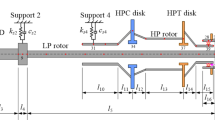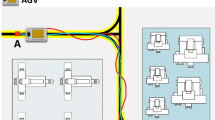Abstract
An accurate prediction method of initial value of high-speed ball bearing model is studyed and its gyroscopic torque is analyzed. First, a new iterative algorithm for high-speed ball bearings is proposed, in which the effects of gyroscopic torque and centrifugal force are considered. Then, to accurately predict the initial values for the proposed iterative algorithm, the combined displacements of bearings are calculated as the initial values according to the deformation superposition principle. The general applicability of this new iterative algorithm for high-speed ball bearings is demonstrated. Subsequently, the effects of combined loads, rotational speed, moment, and raceway groove curvature radius on the gyroscopic torque are discussed in detail. The results provide valuable guidelines for the reasonable selection of combined loads, rotational speed, and raceway groove curvature radii.
Similar content being viewed by others
Abbreviations
- D :
-
Ball diameter (mm)
- r :
-
Raceway groove curvature radius (mm)
- f :
-
r/D
- F :
-
Force (N)
- F c :
-
Centrifugal force (N)
- M :
-
Moment (Nm)
- α 0 :
-
Initial contact angle (0)
- ℜ:
-
Radius of locus of raceway groove curvature centers (mm)
- θ :
-
Angular displacement (rad)
- ψ :
-
Position angle of ball (0)
- δ :
-
Deflection or contact deformation (mm)
- X 1 :
-
Axial projection of distance between ball center and outer raceway groove curvature center (mm)
- X 2 :
-
Radial projection of distance between ball center and outer raceway groove curvature center (mm)
- Q:
-
Ball normal load (N)
- α :
-
Contact angle (0)
- M g :
-
Gyroscopic moment (Nm)
- β :
-
Ball pitch angle (0)
- d m :
-
Pitch diameter (mm)
- Y′:
-
D/d m
- m :
-
Ball mass (kg)
- J :
-
Mass moment of inertia (kg/m2)
- ω :
-
Rotational speed (rad/sec)
- ω m :
-
Orbital speed of ball (rad/sec)
- ω R :
-
Speed of ball about its own axis(rad/sec)
- ξ 1 :
-
Changed contact angle at axial force
- ξ 2 :
-
Changed contact angle at combined forces
- Z :
-
Ball number
- K :
-
Load-deflection factor
- c :
-
Contact deformation coefficient
- ε :
-
Ball load distribution parameter
- a :
-
Axial direction
- r :
-
Radial direction
- j :
-
Ball at angular location
- i :
-
Inner raceway
- o :
-
Outer raceway
- p :
-
Point contact
- n :
-
Direction collinear with normal load
References
C. R. Meeks and K. O. Ng, The dynamics of ball separators in ball bearings-part I: analysis, ASLE Transactions, 28 (3) (1985) 277–287.
A. Palmgren, Ball and Roller Bearing Engineering, S. H. Burbank, Philadelphia (1959).
K. Kakuta, Generating mechanical of friction torque in a ball bearing 1, Mechanism, 2 (1965) 645–648.
L. Oktaviana, V. C. Tong and S. W. Hong, Skidding analysis of angular contact ball bearing subjected to radial load and angular misalignment, Journal of Mechanical Science and Technology, 33 (2) (2019) 837–845.
B. Snare, Rolling resistance in lightly loaded bearings, Ball Bearing Journal, 152 (1968) 3–8.
B. Snare, Rolling resistance in lightly loaded bearings, Ball Bearing Journal, 153 (1968) 19–24.
B. Snare, Rolling resistance in lightly loaded bearings, Ball Bearing Journal, 154 (1968) 3–14.
M. J. Todd and K. T. Stevens, Frictional Torque of Angular Contact Ball Bearings with Different Conformities, Risley, 1978 Technical Report ESA-CR(P)-1221 (1978).
C. R. Gentle and M. Pasdari, Measurement of cage and pocket friction in a ball bearing for use in a simulation program, ASLE Transactions, 28 (4) (1985) 536–541.
R. Trippett, Ball and needle bearing friction correlations under radial load conditions, SAE Transactions, 94 (1985).
C. M. C. G. Fernandes, R. C. Martins and J. H. O. Seabra, Friction torque of thrust ball bearings lubricated with wind turbine gear oils, Tribology International, 58 (2) (2013) 47–54.
V. C. Tong and S. W. Hong, Study on the running torque of angular contact ball bearings subjected to angular misalignment, Proceedings of the Institution of Mechanical Engineers, Part J: Engineering Tribology (2017) 1–20.
V. B. Balyakin, E. P. Zhilnikov, B. B. Kosenok and A. V. Lavrin, Study of the influence of ring misalignment in rolling bearings on frictional torque and the fatigue life of supports, Journal of Friction and Wear, 38 (1) (2017) 7–12.
V. C. Tong and S. W. Hong, Improved formulation for running torque in angular contact ball bearings, International Journal of Precision Engineering and Manufacturing, 19 (1) (2018) 47–56.
J. Liu, Z. Yan and Y. Shao, An investigation for the friction torque of a needle roller bearing with the roundness error, Mechanism and Machine Theory, 121 (2018) 259–272.
M. Hammami, R. Martins, C. Fernandes, J. Seabra, M. S. Abbes and M. Haddar, Friction torque in rolling bearings lubricated with axle gear oils, Tribology International, 119 (2017) 419–435.
T. A. Harris and M. N. Kotzalas, Advanced Concepts of Bearing Technology, Rolling Bearing Analysis, Fifth Edition, Crc Press (2007).
K. Yan, J. Hong, J. Zhang, W. Mi and W. Wu, Thermal-deformation coupling in thermal network for transient analysis of spindle-bearing system, International Journal of Thermal Sciences, 104 (2016) 1–12.
B. Yan, K. Yan, T. Luo, Y. S. Zhu, B. Q. Li and J. Hong, Thermal coefficients modification of high-speed ball bearing by multi-object optimization method, International Journal of Thermal Science, 137 (2019) 313–324.
K. Yan, Y. Wang, Y. Zhu, J. Hong and Q. Zhai, Investigation on heat dissipation characteristic of ball bearing cage and inside cavity at ultra high rotation speed, Tribology International, 93 (2016) 470–481.
C. Brecher, A. Hassis and J. Rossaint, Cage friction in high-speed spindle bearings, Tribology Transactions, 57 (1) (2014) 77–85.
W. Zhang, S. Deng, G. Chen and Y. Cui, Impact of lubricant traction coefficient on cage’s dynamic characteristics in high-speed angular contact ball bearing, Chinese Journal of Aeronautics, 30 (2) (2017) 827–835.
Y. Cui, S. Deng, Y. Ni and G. Chen, Effect of roller dynamic unbalance on cage stress of high-speed cylindrical roller bearing, Industrial Lubrication and Tribology, 70 (9) (2018) 1580–1589.
Y. Li, K. Zhou and Z. Zhang, A flow-difference feedback iteration method and its application to high-speed aerostatic journal bearings, Tribology International, 84 (2015) 132–141.
L. Hassani and R. Ghanbari, The optimization of resilience and sustainability using mathematical programming models and metaheuristic algorithms, Journal of Cleaner Production, 228 (2019) 1062–72.
F. Li, Y. Chen, J. Wang, X. Zhou and B. Tang, A reinforcement learning unit matching recurrent neural network for the state trend prediction of rolling bearings, Measurement, 145 (2019) 191–203.
A. B. Jones, New DeParture Engineering Data: Analysis of Stresses and Deflections, New Departure Division, General Motors Sales Corporation, Bristol, Conn. (1946).
A. Jones, Ball motion and sliding friction in ball bearings, Journal of Basic Engineering, 81 (1959) 1–12.
J. Okamoto, Design and Calculation of Ball Bearing, First Edition, China Machine Press, Beijing, China (2002).
G. Richard, J. Budynas and N. Keith, Shigley’s Mechanical Engineering Design, Ninth Edition, CRC Press, Beijing, China (2009).
W. Wang, L. Hu, S. Zhang and L. Kong, Modeling high-speed angular contact ball bearing under the combined radial, axial and moment loads, Proceedings of the Institution of Mechanical Engineers, Part C: Journal of Mechanical Engineering Science, 228 (5) (2014) 852–864.
Acknowledgments
The authors would like to thank the National Natural Science Foundation of China (No. 51605354), the Overseas Expertise Introduction Center for Discipline Innovation (No. B17034) and the Major Program of Science and Technology Program of Hubei Province (No. 2018AAA030) for the support given to this research.
Author information
Authors and Affiliations
Corresponding author
Additional information
Lina Hao is currently a graduate student majoring in Mechanical Engineering at the School of Automotive Engineering, Hubei Key Laboratory of Advanced Technology of Automotive Components at Wuhan University of Technology, China. Her research areas include structure design and dynamic behavior of high-speed bearing.
Dongsheng Qian received his Ph.D. degree in Mechanical Engineering from Wuhan University of Technology, China, in 2009. Qian is currently a Professor at the School of Materials Science and Engineering, Hubei Key Laboratory of Advanced Technology of Automotive Components at Wuhan University of Technology, China.
Song Deng received his Ph.D. degree in Vehicle Engineering from Wuhan University of Technology, China, in 2014. Deng is currently an Associate Professor at the School of Automotive Engineering, Hubei Key Laboratory of Advanced Technology of Automotive Components at Wuhan University of Technology, China. His research areas include structure design and dynamic behavior of high-speed bearing.
Lin Hua received his Ph.D. degree in Mechanical Engineering from Xi’an Jiaotong University, China, in 2002. Dr. Hua is currently a Professor at the School of Automotive Engineering, Hubei Key Laboratory of Advanced Technology of Automotive Components at Wuhan University of Technology, China. Dr. Hua’s research interests include advanced manufacturing technology.
Rights and permissions
About this article
Cite this article
Hao, L., Deng, S., Qian, D. et al. Accurate prediction method of initial value of high-speed ball bearing model and gyroscopic torque analysis. J Mech Sci Technol 34, 3745–3755 (2020). https://doi.org/10.1007/s12206-020-0826-8
Received:
Revised:
Accepted:
Published:
Issue Date:
DOI: https://doi.org/10.1007/s12206-020-0826-8




